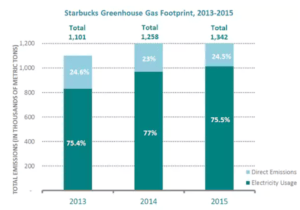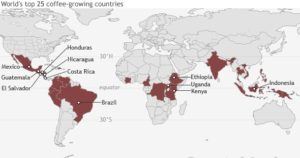A love affair in peril: Starbucks’ impending battle with climate change

Climate change is poised to halve the arable land available to grow coffee by 2050; meanwhile, demand for coffee in the United States continues to grow rapidly. In 30 years, will Starbucks have enough coffee beans to meet demand? What actions is the company taking to mitigate supply risk and to help slow down the impact of climate change globally?
Millennials love their coffee because “it provides them everything they love: status, experience, and personalization” [1]. This love affair is growing stronger in 2017 as 62% of Americans are drinking coffee daily, compared to 57% in 2016, with the largest growth among those from 13 to 18 years of age [2]. But as demand continues to grow, climate change is projected to dramatically reduce coffee bean yields and the arable land available to grow coffee [3]. Ultimately, this will create major raw material supply risk for Starbucks, one of the world’s largest buyers and sellers of coffee worldwide.
The emerging problem and why Starbucks should be concerned
Brazil and Central America currently grows a majority of the most popular type of coffee, Arabica. According to the International Center for Tropical Agriculture, if earth’s temperature rises as projected, “80% of the land currently used to grow Arabica is expected to become unsuitable to the crop by 2050. Over the same period, the Climate Institute expects a 50% decline in suitable land globally” [3][4]. This change is also poised to impact the economic well-being of more than 120 million people world-wide that rely on the coffee economy [5]. Naturally, this puts Starbucks’ supply of coffee beans at risk – a risk that can’t solely be mitigated by diversifying the supplier base. If not effectively addressed, this emerging problem could make it difficult for Starbucks to meet the growing demand for coffee and dramatically increase the company’s cost of goods sold – potentially forcing it to pass on the increased cost to adoring consumers in hopes of maintaining attractive gross margins.
Coffee energizes Starbucks to act
Since the primary effect of climate change on coffee growers will be a decrease in yield, Starbucks has established the Global Farmer Fund Program to develop a “network of farmers around the world who are equipped with financing to renovate their farms and implement sustainable growing practices” [6]. This program requires farmers to follow a set of standards that “include using shade and tree conservation to protect crops, and managing risks from pests and disease spurred by changes in climate” [3]. This action is analogous to a company like Toyota teaching its suppliers how to improve manufacturing and operations practices to establish a more reliable and efficient supply source for itself. Starbucks is also helping its farmers by providing them with seedlings that are resistant to certain diseases like leaf rust, a condition exacerbated by climate change [3]. Though this may increase Starbucks’ cost, it should help its suppliers stay afloat and maintain a reliable supply source.
While these actions should help Starbucks in the shorter term, the company is also positioning itself for a markedly different agriculture environment in the future. For example, in 2013 Starbucks bought its own coffee farm in Costa Rica and utilized it as an experimentation facility – “testing different coffee growing methods and developing plants that could survive in warmer temperatures” [3]. The latter is fascinating because it’s a harbinger of a potential increase in the use of genetically or biologically modified crops, seeds, or fertilizers to combat the effects of climate change.
Two other overarching steps Starbucks can take to address the impending risks to its supply chain
First, Starbucks should implement operational changes aimed at reducing its own carbon emissions and therefore slowing down the effects of climate change. Specifically, focus on reducing electricity usage at each Starbucks store. In 2015, electricity usage accounted for 75.5% of Starbucks’ total greenhouse gas emissions [7]. An incremental action that Starbucks has yet to implement is to replace the open-door refrigerator display cases that are currently used in stores with glass-doored cases. Though this could slightly hurt the customer purchasing experience, it may reduce energy consumption of the refrigerator units by potentially 20-30% as “open display cases consume approximately 1.3 times more energy than doored cases” [8].
Second, Starbucks should consider facilitating the growth of coffee farms in geographies that traditionally have not been well suited to grow coffee. “The optimal temperature to grow Arabica coffee is 64o-70o F, which is most commonly found in upland elevations of tropical countries” [9]. Though climate change will reduce yield in these regions, it may make California’s southern coast – according to Willem Boot, a consultant to the coffee industry – and other similar regions around the world more suitable for coffee cultivation [10]. Effectively, this would serve as a long-term hedge against reduced coffee production from current suppliers.
As Starbucks continues to combat the negative effects of climate change on its supply chain, there are two open questions it must consider: one, what responsibility, if any, does it have in supporting the current coffee growers who are at risk of losing their livelihoods; and two, should it pass on the incremental costs of improving sustainability and reducing carbon emissions to consumers?
(789 words)
Bibliography
- Heath, Thomas. “Look how much coffee millennials are drinking.” The Washington Post, WP Company, 31 Oct. 2016, washingtonpost.com/news/business/wp/2016/10/31/look-how-much-coffee-millennials-are-drinking/?utm_term=.dbf1a66aa6b8
- Gruber, B. F. (2017, 05). Daily coffee consumption INCREASES among americans, gourmet varieties DRIVE increase.Automatic Merchandiser, 59, 14-14,16. Retrieved from http://search.proquest.com.ezp-prod1.hul.harvard.edu/docview/1900796164?accountid=11311
- Byrmes, Nanette. “Starbucks Responds to Climate Change, with Mixed Results.” MIT Technology Review, 9 May.2016, https://www.technologyreview.com/s/601404/starbucks-responds-to-climate-change-with-mixed-results/
- Slawson, Nicola. “Coffee and climate change: what you need to know.” The Guardian, Guardian News and Media, 27 Sept. 2016, theguardian.com/sustainable-business/2016/sep/27/coffee-climate-change-supply-chain-risk-smallholders-fairtrade-tech .
- Slezak, Michael. “Climate change predicted to halve coffee-Growing area that supports 120m people.” The Guardian, Guardian News and Media, 29 Aug. 2016, theguardian.com/environment/2016/aug/29/climate-change-predicted-to-halve-coffee-growing-area-that-supports-120m-people.
- Starbucks company website: https://www.starbucks.com/responsibility/sourcing/coffee
- Starbucks company website: https://www.starbucks.com/responsibility/environment/climate-change
- Fricke, Brian and Becker, Bryan, “Energy Use of Doored and Open Vertical Refrigerated Display Cases” (2010). International Refrigeration and Air Conditioning Conference. Paper 1154. http://docs.lib.purdue.edu/iracc/1154
- Climate & Coffee | NOAA Climate.Gov, 19 June 2015, climate.gov/news-features/climate-and/climate-coffee .
- Strom, Stephanie. “Your Coffee Is From Where? California?” The New York Times, The New York Times, 26 May 2017, nytimes.com/2017/05/26/business/your-coffee-is-from-where-california.html .





Thank you for great article!
I find passing on the incremental costs of improving sustainability to consumers a natural way for Starbucks to adjust to the new reality in the short term. Starbucks increased prices as much as 30% every summer for the last three years [1], thus I believe that customers are used to price hikes. However, one major risk I can see is that Starbucks can’t keep increasing prices with such magnitude forever. Ultimately, they will need to find more efficient solutions for the long term.
[1] http://fortune.com/2016/07/12/starbucks-prices-coffee/
While the proposed measures sound valuable, I believe they will only cause incremental improvements and will not be able to avoid a complete disruption of the coffee industry. The fact is that a decline of supply (in terms of suitable land) of 50% is expected in the future (as mentioned above), therefore even if harvest technologies are improved the coffee supply in the future will probably not be sufficient to satisfy demand. Therefore, I believe Starbucks should consider a strategic shift, which in my opinion could go in three directions. One, where it diversifies its drinks base further and moves away from a dependence on coffee. Two, where Starbucks competes for coffee beans on price (against other competitors) and sells coffee at a high premium, thus becoming a luxury brand. Three, it could investigate alternative ways of creating coffee beans, e.g. genetic modification to adjust coffee plants to new climate conditions. While there are benefits and drawbacks for all options, I see the value in pursuing any of them – but this does not seem to be the case currently.
Nikhil, thank you for the great post! As an avid coffee drinker, it is interesting to see what challenges lie in the future for the coffee industry.
Another impact we are seeing from global warming comes in the quality of the coffee produced. When coffee is allowed to grow in colder temperatures, the beans ripen in a slower fashion – allowing complex flavors to develop. However, as the weather turns warmer, the beans ripen faster and yield a more plainly tasting coffee. Global warming also affects crops by creating droughts and extreme weather events. [1]
I completely agree that Starbucks needs to prepare for the future by experimenting with more heat and plague-resistant strains of the coffee plant and providing the results to their current growers, as well as by anticipating which new areas will become suitable for growing coffee in the future.
I also support the idea of installing energy-efficient refrigerators in the stores. I think that the Starbucks customer base, in general, would be receptive to the change if the chain explained the purpose behind it. The customer promise would not be altered by these changes.
[1] http://www.cnn.com/2017/06/21/world/coffee-climate-change-trnd/index.html
Nikhil, great essay which hits on a topic very close to my heart – coffee! As an Australian I must confess I generally try to avoid Starbucks coffee, but I admire the company for consistently being a leader in doing business the right way by focusing on taking care of its staff, customers, and the environment. With millennials increasingly drinking from more local, independent cafes which invariably charge much higher prices than Starbucks, I have no doubt that there is significant headroom for the company to increase prices and pass on the incremental costs of sustainable practices to consumers, especially given Starbucks’s customers have a reputation for generally being environmentally conscious.
However, given Starbucks’s reputation as being somewhat of a trailblazer in such areas, I wonder if the company could do more and work with other large industry players to reduce the dependence on Arabica coffee given its impending shortage. For example, as Erica’s essay pointed out, the two largest Italian coffee suppliers – Illy and Lavazza – have partnered together along with some Italian universities to sequence the Arabica genome for the first time in order to eventually cultivate plants that are more resistant to the effects of climate change. [1]
References:
[1] http://valuereport.illy.com/pdf/BILANCIO_illy_ECONOMICO.pdf